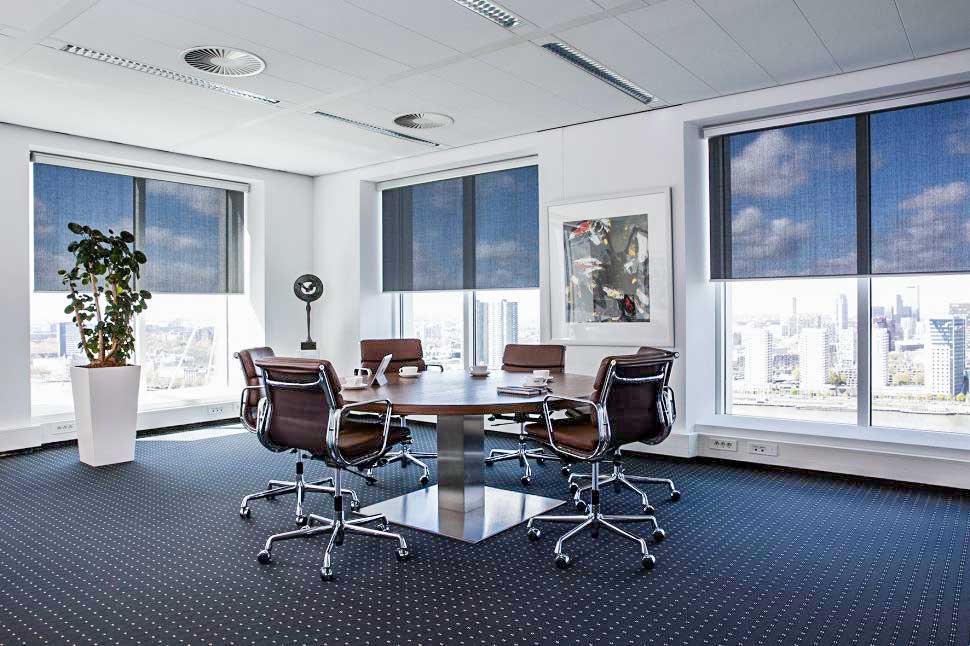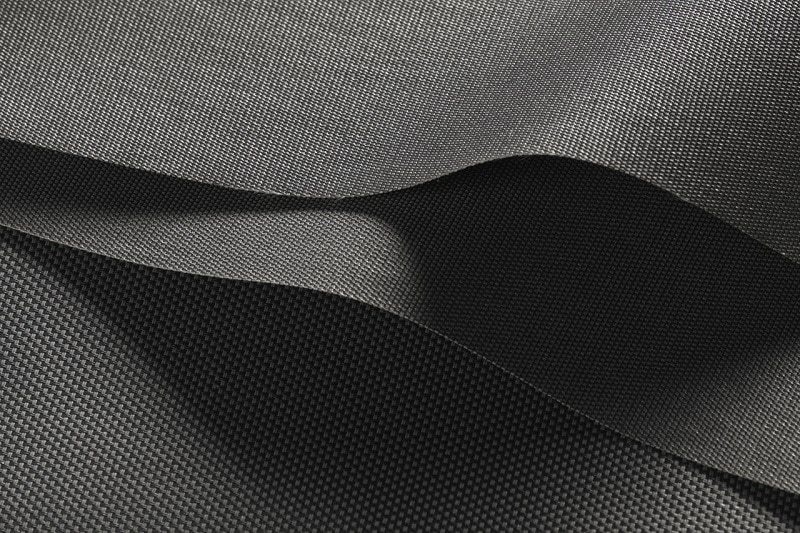
Blind fabrics explained: What options are available to businesses?
If you’ve been given the task of choosing a blind fabric for commercial premises you’ve no doubt realised that there is a vast range to choose from.
The best way to choose fabrics for blinds is not necessarily to focus solely on the visual aspects of the product.
Although aesthetics are very important, there are additional considerations to take into account when it comes to sourcing blinds for business premises, retail outlets, hospitality venues and public buildings. Different fabrics serve different functions.
To help you specify the right blind fabric for the job, we will discuss 9 different types of fabric options available and their qualities.
9 Types of Blind Fabric Explained
Sustainable fabric
If you have a client with a strong environmental awareness, the fabric choice of the blinds you specify is going to be very important. You will need to look for fabrics which are produced using recycled materials and sustainable manufacturing processes that contain no harmful toxic materials.
One way to make sure you’re specifying the most environmentally friendly fabric option is to check if it has an Environmental accreditation, and to evaluate which accreditation is best suited to the needs of your client. There are various accreditations, each with different criteria and tiers, the most common are:
- Greenguard
- REACH
- OekoTex 100
- Cradle to Cradle
PVC is very common in blind fabrics as it increases its strength, however, it can give off harmful volatile organic compounds (VOCs). To pass accreditations like Greenguard and OekoTex 100 these VOCs must be less than predetermined levels which are not considered to be a danger to health. However, many environmentally conscious clients choose PVC free fabrics.
This will ensure that the blinds you recommend have been tested and are scientifically proven to lower chemical emissions and can be recycled when they are no longer needed.
Waverley supplies a range of sustainable blind fabrics, with differing levels of certification. You can explore the range by using the ‘Sustainability’ filters on our blind fabrics collection.
High performance fabric
Commercial blinds will need to work a lot harder than their domestic counterparts. Their main role is to help maintain a comfortable room temperature and guard against light and glare while allowing enough natural light into a space. The different fabric characteristics will determine how well they perform.
High performance blind fabrics have been engineered to provide the highest standards of visual and thermal performance. They typically have a thin, highly reflective aluminium backing, which provides exceptional glare and solar heat gain control, whilst retaining great through vision.
High performance fabrics are not dependent on the colour chosen, unlike other types of fabric. Studies have shown that metallised fabrics can reflect up to 82% of the solar energy entering the building through the glass – which is comparable performance to externally mounted blinds, without the drawbacks of maintenance. For businesses, there’s no doubt that high performance fabric is a compelling choice, as it has the potential to have a massive impact on your building’s overall efficiency and the well-being of the occupants.
For information on high performance fabrics, take a look at our collection of Verosol high performance blind fabrics.
Flame retardant fabric
When it comes to installing blinds in public buildings and offices, Building regulations require companies to install blinds manufactured using fire retardant fabrics to British Standards BS 5867 or equivalent.
Flame retardant fabric will be described as “FR” and is designed to improve the resistance to ignition and reduce the rate at which a flame will spread across the surface.
BS 5867 has three levels A, B and C. It is recommended that blind fabrics used in public buildings such as schools and offices should meet level B and this is mandatory for healthcare environments as set out in HTM 05-03. (This can sometimes be confused with the requirement for curtains which have to meet the higher type C requirements for healthcare environments).
Screen fabric
Screen fabrics are specifically designed to provide glare and solar heat gain control whilst allowing a view to the outside. They come in various openness factors e.g. 2%, 3%, 5% which is the amount of ‘hole’ in the fabric measured as a percentage of the whole area covered by the fabric. Obviously the larger the openness factor, the more light that will pass through, and the easier it will be to see through. However, the colour choice of the fabric will also hugely impact its performance.
Black or dark fabrics will give excellent glare control, but dark colours absorb a high amount of solar energy, therefore they’re poor at controlling solar heat gain. At the other end of the scale, white or light coloured fabrics will give excellent solar heat gain control but poor glare control. This is because light not only passes through the ‘holes’ in the fabric but is also diffused through the yarns of the fabric, causing glare and preventing our eyes from focusing on the view through to the outside.
The amount of light passing through the blind is also measured as a percentage, known as the Tv% measurement. The lower this is, the better the fabric will perform at controlling the glare. BREEAM and other sustainability accreditations stipulate that this Tv value must be less than 10%. However, our experience and independent testing have shown that for office and classroom environments, this figure should be 7% or less to achieve adequate glare control.
The ideal fabric ultimately needs to have the largest ‘openness factor’ to give a good view through, along with low Tv% to control glare and high reflectivity (or low absorption) to control solar heat gain. With traditional fabrics this usually leads to a compromise with one of the grey colours chosen, however, high performance metallised fabrics are available which allow a choice of colours without affecting the performance (see item 9 below).
Blackout fabric
When it comes to blackout fabric there are a few options to choose from. One of the main factors to consider will be whether the blinds are to be a ‘ fully framed blind’ for total room darkening, or whether the fabric will be mounted on a standard roller blind – allowing some light to leak around the edges. This is because some fabrics are not suitable for use on fully framed blinds, as they are not suitable for welding.
Generally speaking, fabrics with a PVC coating such as DeltaBlock 40 and DeltaBlock 30 are suitable for fully framed blinds, whereas polyester fabrics with an acrylic blackout coating such as ThetaBlock 60 are not. All types of blackout fabric can be used on a standard roller blind but care needs to be taken on the sizing, due to the limitations of joining by welding. (Covers can be joined by stitching them together but this can cause irritating pinpoints of light).
Dim-out fabric
Unlike blackout fabrics which ‘block’ out 100% of light, dimout fabrics will still allow a certain amount of light to pass through the fabric, but like blackout fabrics, they do not allow a view through. The amount of ‘dimming’ they provide is directly affected by the colour chosen – with darker colours darkening the room to a greater extent than lighter colours. Using a polyester fabric such as Sigmatex 60, is a cost-effective way to reduce the amount of light coming into a room.
Privacy fabric
Essentially a ‘Privacy fabric’ is any fabric with a 0% openness. Both ‘Blackout’ and ‘Dim-out’ fabrics can be used where privacy is required depending on the degree required. Depending on the colour selected, a dim-out fabric may allow shadows to be seen through it, whereas a blackout fabric by its nature will block the view entirely. Screen fabrics with a small openness factor can be used for privacy, but they will always allow a view through towards the brightest light source. For example, during the day a screen fabric will prevent people from seeing in, but at night this will be reversed, when the lights are switched on inside the building.
Acoustic fabric
Robust and specially woven fabric can help window blinds to improve the acoustics of a room or area.
Modern designs often incorporate large areas of glazing and other hard surfaces which can impact negatively on the acoustics of the area, creating echoes and amplifying noise. Blinds with acoustic fabric can be used as a window treatment, whilst reducing reverberation throughout the space. They can also be used as space dividers in larger areas, visually breaking the area up and providing acoustic performance.
Metallised fabric
This type of fabric includes a highly reflective aluminium coating, making it a great choice to tick a number of the category descriptions above. Metallisation improves both the solar heat gain and glare control performance, virtually eliminating the influence of the colour chosen (see item 4 above).
High performance metallised fabrics are a great choice for office environments, as they can significantly reduce running costs by effectively reducing solar heat gain and reducing reliance on air conditioning. Metallised fabrics contribute significantly to the well-being of the occupants by eliminating screen glare, whilst maintaining a connection to the outside.
Advice on specifying fabrics for blinds that are fit for purpose
If you are still unsure which option to choose, or you are sourcing for large locations or multiple buildings, getting expert advice can make the process much easier. The team at Waverley enjoy sharing their product knowledge and offer a responsive service, going above and beyond to deliver the right systems and fabrics for our clients.





